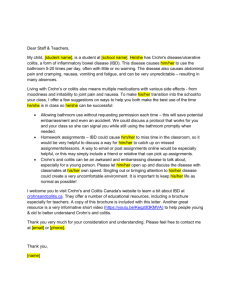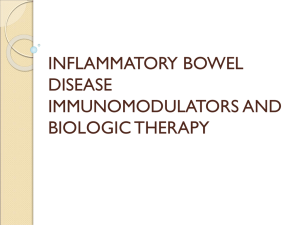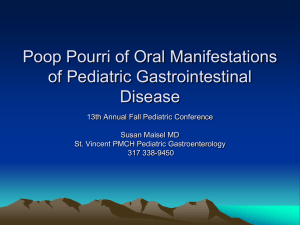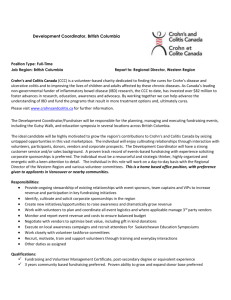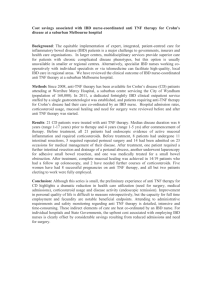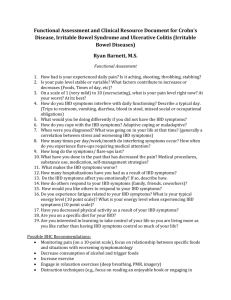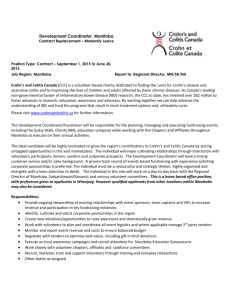Inflammatory Bowel Disease
advertisement
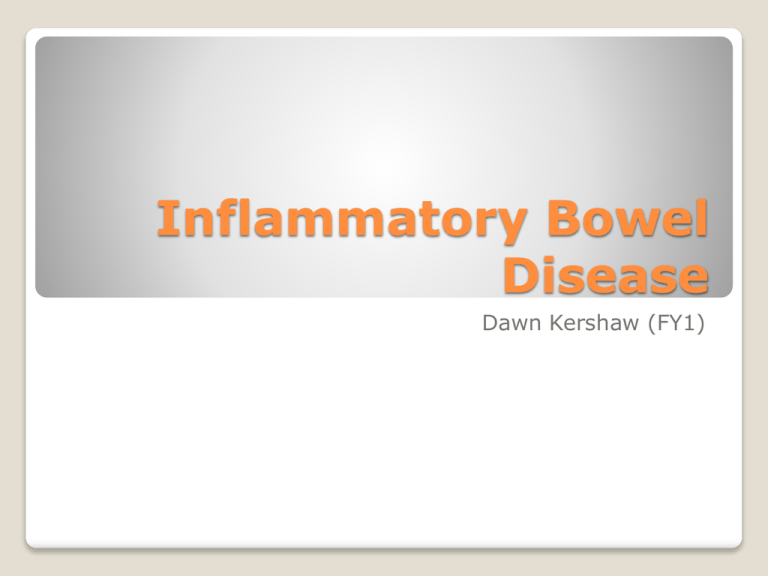
Inflammatory Bowel Disease Dawn Kershaw (FY1) Objectives Recognise the possibility of IBD in patient’s presenting with lower GI symptoms Recognise the possibility of systemic symptoms associated with IBD Recognise the differences in presentation between Crohn’s and UC – and how these relate to underlying pathology Initiate appropriate investigations in a patient with suspected IBD Initiate appropriate management in a patient with IBD Explain to patients the nature of and the rationale for maintenance treatment of IBD Objectives Recognise the possibility of IBD in patient’s presenting with lower GI symptoms = GI symptoms of IBD Recognise the possibility of systemic symptoms associated with IBD = Extra-intestinal symptoms Recognise the differences in presentation between Crohn’s and UC – and how these relate to underlying pathology = Differences between UC and Crohn’s: Pathology and presentation Initiate appropriate investigations in a patient with suspected IBD = Investigations Initiate appropriate management in a patient with IBD = Management of IBD Explain to patients the nature of and the rationale for maintenance treatment of IBD = Explain in lay terms why we give medications to prevent flare ups Definition? Aetiology? Crohn's verses UC Crohn's verses UC Definition ◦ ◦ ◦ ◦ Chronic Relapsing and remitting Inflammatory bowel disease Chrons: any part of GI tract - often terminal ileum ◦ UC: large bowel Aeitology ◦ Unknown ◦ Genetic ◦ Environmental Pathology? Crohn’s Crohn’s Tranny Granny Skipped down Cobblestone street Strictures Fistulae Abscesses Crohn’s Ulcerative colitis ◦ ◦ ◦ ◦ Starts from rectum Extends proximally Continuous Mucosa only Proctitis = rectum Proctosigmoiditis = rectum and sigmoid colon Left sided Colitis Pancolitis – Whole of large colon Objectives Recognise the differences in presentation between Crohn’s and UC – and how these relate to underlying pathology Recognise the possibility of IBD in patient’s presenting with lower GI symptoms Crohn’s Crohn’s Crampy abdominal pain ◦ Inflammation; fibrosis; bowel obstruction Diarrhoea ◦ Blood ◦ Steatorrhea Weight loss Fever Anaemia Obstruction: Distension, Vomiting Abscesses Fistulae: Enteroenteral; Anorectal; Vesicointestinal; Rectovaginal Ulcerative Colitis Ulcerative Colitis Crampy abdominal pain ◦ Relieved by defecation ◦ Left iliac fossa Diarrhoea ◦ Blood ++ ◦ Mucous Urgency Tenesmus Weight loss Fever Anaemia Severity: Truelove Witts Criteria Objectives Recognise the possibility of systemic symptoms associated with IBD. Extra-intestinal symptoms Eyes ◦ Iritis; uveitis; episcleritis Skin ◦ Erythema nodosum; pyoderma gangrenosum Joints ◦ Seronegative spondyloarthropathy Large joints; Spine; Sacroiliitis; Can affect small joints Other ◦ ◦ ◦ ◦ ◦ Clubbing DVT Primary sclerosing cholangitis (UC) Heamolytic anaemia (autoimmune) (Crohn’s) Osetoporosis (Crohn’s) Erythema nodosum Pyoderma gangrenosum Uveitis Clubbing Get into 2 groups Complete first 3 boxes on form based on what we have just done. What are your differential diagnosis to consider in a patient presenting with IBD symptoms? ◦ ◦ ◦ ◦ ◦ Abdominal pain Diarrhoea PR bleeding/ mucous Weight loss Malabsorption (Thanks to Zoe Campbell for providing the basis to this form) Initiate appropriate investigations in a patient with suspected IBD Bedside Bloods Imaging Special tests Investigations Bedside ◦ Stool MC&S ◦ Faecal calprotectin Bloods ◦ ◦ ◦ ◦ FBC (low Hb; High WCC) ESR; CRP (high) LFTs: Low albumin U&Es: Chronic diarrhoea – electrolyte imbalance ◦ Heamatinics: ferritin, Vitamin B12, folate ◦ Amylase ◦ Cross match Investigations Imaging ◦ Abdominal X-ray ◦ Erect Chest X-ray ◦ Barium Meal (Crohn's) Fibrosis, Strictures, Ulceration (‘rose thorn’) ◦ Barium enema (UC) Featureless narrow colon, Loss of haustral pattern ◦ CT/MRI enterography (Crohn’s) Special test ◦ ◦ ◦ ◦ Flexible sigmoidoscopy Colonoscopy Gastroscopy BIOPSY Initiate appropriate management in a patient with IBD Acute Chronic Lifestyle MDT Management Acute ◦ ◦ ◦ ◦ A-E; Bowel rest; Analgesia (not NSAIDs); Steroids: IV; oral; rectal Antibiotics 5-ASAs Chronic ◦ 5-ASAs ◦ Per rectum steroids ◦ Immunosuppressant's Azathioprine Methotrexate (Crohn’s) ◦ Anti-TNF: Infliximab Surgery: Resection Management Lifestyle ◦ Diet: Elemental ◦ Stop smoking? MDT ◦ ◦ ◦ ◦ ◦ Consultant’s: Gastroenterologist; Surgeons IBD specialist nurse Dietician Smoking cessation Stoma nurse 5-ASAs Steroids Azathioprine/ Mercaptopurine (Immunosuppressant) Methotrexate (Crohn's) Infliximab (Anti-TNF) Medications used in IBD Complete the rest of the form Get back into groups Objectives Explain to patients the nature of and the rationale for maintenance treatment of IBD Patient.co.uk Once a flare-up has settled, without treatment, there is ~1 in 2 chance that another flare-up will develop within a year. Increased likelihood of flares depends on: ◦ extent of the disease in your gut ◦ age, ◦ the extent of treatment needed to control the initial flare-up. If flares not frequent/mild/ respond well to acute treatment then - may not need to /wish to take regular meds For others regular meds can improve QOL ++ The treatment options that may be considered to prevent flare-ups) include: Immunosuppressants – take daily Mesalazine – used daily (less common now) Anti-TNF – selected cases where flares severe and other treatments not worked: Have infusion in hospital every 8 weeks. Steroid medication is not generally used longterm to prevent flare-ups These treatments increase the chance of remaining free of flare-ups, but they do not always work. Balance between benefits and the possible side-effects. 3 key points to take away Understanding the pathophysiology of UC and Crohn’s is actually useful! ◦ Symptoms ◦ Investigations ◦ Management Communication is key- in exams AND in real life: ◦ Patient.co.uk ◦ Easy marks in exams if you practice! Structured answers in exams ◦ Investigations Bedside; Bloods; Imaging; Special tests Acute; chronic ◦ Management Acute; Chronic; lifestyle; MDT Conservative; Medical; Surgical
